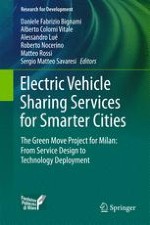This book examines electric car sharing in cities from a variety of perspectives, from service design to simulation, from mathematical modeling to technology deployment, and from energy use improvement to the integration of different kinds of vehicle. The contents reflect the outcomes of the Green Move project, undertaken by Politecnico di Milano with the aim of fostering an innovative and easily accessible electric vehicle sharing system. The first section of the book illustrates the car sharing service, covering service design, the configuration of the vehicle sharing model and the Milan mobility pattern, analysis of local demand and supply, testing of the condominium-based car sharing model, and communication design for social engagement. The second section then explains the technological choices, from the architecture of the system and dynamic applications to information management, the smartphone-based energy-oriented driving assistance system, automatic fleet balancing systems, and real-time monitoring of vehicle positions. In the final section, readers will find descriptions of the simulation model, a model to estimate potential users of the service, and a model for a full-scale electric car sharing service in Milan.
